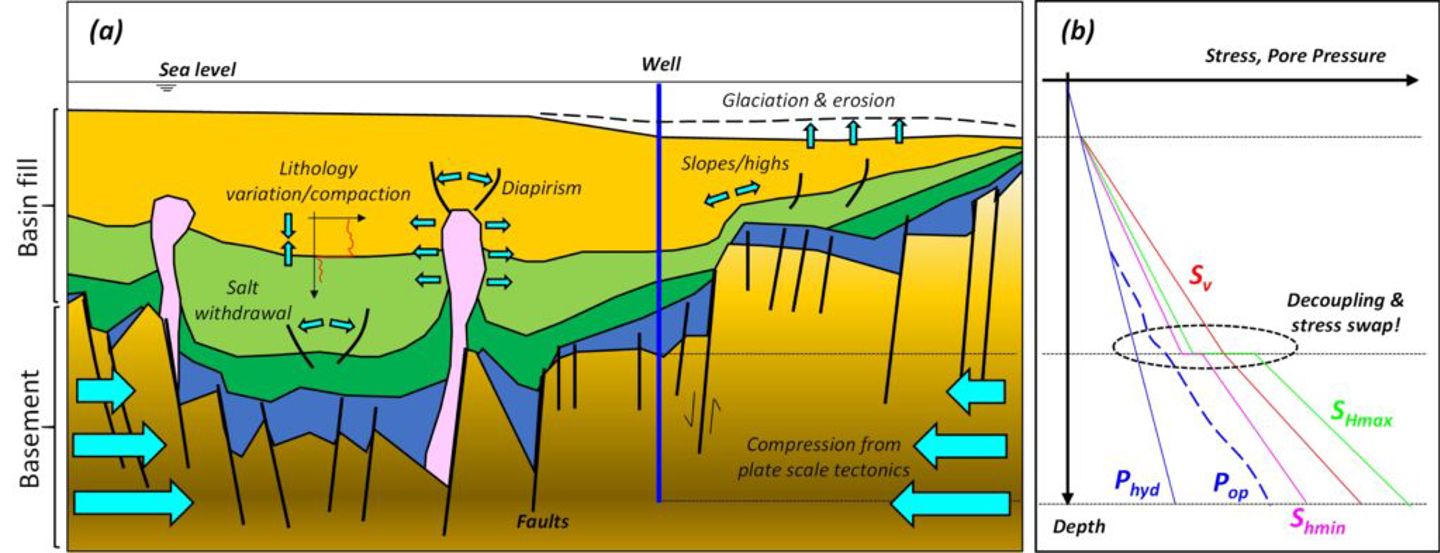Work Package 1: Stress history

WP lead: Daniel Roberts, Rockfield. E-mail: daniel.roberts@rockfieldglobal.com
The main objective in WP1 is to capture and quantify the processes controlling in situ stress for the principal study site(s); Horda Platform (Aurora/Smeaheia) and Southern North Sea (Greater Bunter Sandstone), applying advanced modelling techniques.
Detailed prediction of in situ stress and the geomechanical response to CO2 injection is critical for identifying and mitigating associated risks. This is particularly relevant in the context of injection-induced seismicity and assessment of cap-rock/seal integrity, where the degree to which faults and fractures are susceptible to reactivation will depend largely on the local configuration and magnitudes of in situ stress.
Task 1.1 – Data collation and evaluation of stress drivers
A first phase will consist of detailed inventory of supplied data sets for the proposed storage sites. This will include assessment of the supplied regional/field scale interpretations, in situ stress measurements, log data and rock mechanics test data This will be complimented by literature studies to provide the appropriate context and develop the tectonostratigraphic frameworks for the study sites. This will identify some of the key contributors to stress evolution that require consideration in the subsequent modelling work.
As the focus area will be the North Sea Basins, a detailed study of glacial contributions to stress on both regional/local scales is necessary and will be undertaken This work will also incorporate outcomes and understanding derived from previous shallow geotechnical studies. Furthermore, machine learning techniques will be applied for big data handling and used to derive 3D distribution of stress from analysing logs and 3D inverted seismic cubes for the selected study areas.
Task 1.2 – Assessment of lithological contributions to in situ stress and constitutive model development
This task will focus on determining the relative contribution of initial deposition and mineralogy, burial history including diagenesis, erosion, uplift and glacial loading to the current in situ stress in the North Sea Basin. This will include exhumation studies using supplied logs in combination with lithology dependent (rheological) compaction and uplift behaviour extracted from existing database of soils and rocks, supplemented by the rock mechanical data shared by the storage site operators. This phase will be revisited, and modelling expanded based on the results from dedicated experimental testing for the key study areas undertaken in WP3.
Task 1.3 – Construction of geomechanical models
This task will construct 2D and 3D geomechanical models of the detailed study areas in Horda Platform and Greater Bunter Sandstone. Supplied data and regional experience will be used to build the models. It is anticipated that both regional and local studies will be undertaken.
Models offer the possibility for stress interrogation over the entire deformation history, and export of the final stress distribution. The derived stress distributions will further be utilized to optimise the experiment design in WP3; and the stress field will be used as input to the failure prediction in WP4 and the estimation of failure probability in WP5.
Task 1.4 – Calibration & “sharpening” of model predictions
This task will be concerned with integrating of seismicity data and calibrate the models. Passive seismic data will be used to provide constraints on stress orientation and magnitude as derived from earthquake data and seismic anisotropy. The stress distribution from the geomechanical models will be compared to current fault networks; when combined with seismicity maps this will help determine active faults and the assessment of potential decoupling will be accorded a high priority.